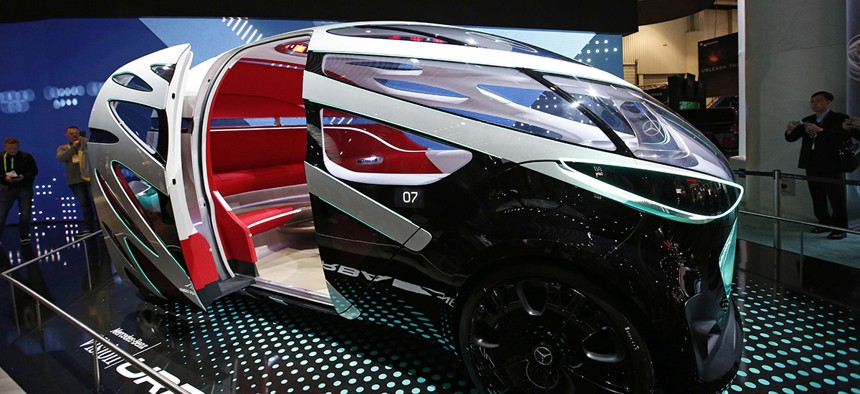The ‘Driverless Experience’ Looks Awfully Distracting

The Mercedes-Benz “Vision Urbanetic,” a passenger/freight mashup concept for urban transportation needs, is on display at the Mercedes-Benz booth at CES in Las Vegas. John Locher/AP
At CES 2019, carmakers showed off vehicles with perfume-puffing headrests, augmented-reality video displays, and all manner of in-car entertainment.
At the Consumer Electronics Show in Las Vegas this week, it looks like the Year of the Self-Driving Car. More than 30,000 square feet of floor space at this annual technology exhibition are covered with technology pointing to an autonomous future: super high-definition maps, LIDAR cameras, and dazzling new vehicles designed to cosset, amuse, and sell stuff to the people inside them.
Indeed, many of the gadgets and ideas on display have less to do with vehicles’ abilities to fully drive themselves—which remains very much a work-in-progress—and more to do with what people will do when they don’t have to drive.
What will the “driverless experience” entail? Lots of staring at each other (or at screens) and not the road, based on a few carmakers’ concepts. Mercedes rolled out an urban ride-hailing/freight delivery van concept with wraparound seating that groups passengers by the length of their trips. Japanese parts maker Denso showed off a rolling cube with boardroom-style seating and a shared work surface, envisioning a shared mobility service for office drones on the go.
Some robo-cars will apparently offer the equivalent of in-app purchases. Donning Oculus-style glasses inside an upholstered sphere, I took a ride in the virtual-reality demo for a self-driving rental concept by the French automaker Valeo. On the way from virtual airport to hotel, I could (pretend to) pay extra for audio books, window privacy screens, some sort of personalized lighting scheme, scans of outside air quality, and other upgrades. Afterward, a Valeo rep handed me a survey about how much I’d shell out for such features in the real world. The only worthy up-sell, I’d imagine, would be those window shades for vacationers eager to get busy.
Other car companies seem convinced that passengers will need more help keeping themselves occupied. Nissan demoed a truly head-spinning VR/AR/AV mashup concept, where a navigation system, entertainment display, and communications platform are all projected into the interior of the car, allowing family and friends to join as “three-dimensional, augmented-reality avatars to provide company or assistance.” Leaping even further into the realm of speculative transportation, Kia declared the arrival of the “post-autonomous driving era,” with a display of vehicle simulation pods that detect passenger emotions and program en-route entertainment accordingly. For me, this meant watching a video of taiko drummers projected onto the space where a windshield would be, accompanied by puffs of unidentifiable perfume squirted from my headrest. Afterwards, the car informed me that my facial scan registered as mostly “joyful” but partly “tired.”
The truly curious thing about these displays, though, is how far the industry is from providing the critical hardware that underlies such heavily programmed automotive futures: that is, self-driving cars that can reliably drive themselves in all kinds of conditions.
In 2018, after several years of hype and turbocharged competition between carmakers and technology companies, the industry tapped the brakes on short-term promises about the widespread arrival of fully autonomous cars. Car companies still haven’t perfected the “handoff” of driving responsibility between person and machine for the lower levels of autonomy—those cars that can handle most driving demands, but still require human eyes stay alert to intervene when necessary.
The enormous challenge presented by the flesh-to-robot transition was highlighted by two tragedies last year: the death of a pedestrian by an autonomous Uber with a distracted human backup driver behind the wheel, and a fatal highway crash by a Tesla in Autopilot mode. No wonder polls reveal persistent skepticism and distrust among would-be consumers.
All of this has given self-driving automakers considerable pause. Even Waymo, the Google spinoff widely regarded as the industry’s leader, is still using human backup drivers in the fleet of robotic taxis it brought to market in Arizona last month. John Krafcik, the firm’s CEO, recently shared his belief that self-driving cars will never be fully reliable under all weather and driving scenarios.
From a safety perspective, then, the array of in-car baubles on parade at CES could be cause for concern. Vehicle fatality rates are as high as they were a decade ago, and digital distractions are often fingered as a leading cause. Already, car companies don’t sufficiently educate drivers about all the pings and pongs packed inside their vehicles, said Deborah Hersman, the president and CEO of the National Safety Council who is soon to be Waymo’s first-ever Chief Safety Officer, at the CES keynote panel on Tuesday. She cited a 2015 national driver’s survey by the University of Iowa that found 40 percent of respondents had been surprised to find their vehicle behaving in some unexpected manner, such as delivering alerts from the rearview backup camera, advanced cruise control, anti-lock braking system, or other newfangled feature.
By piling on increasingly complex features and entertainment options before passenger vehicles reach full autonomy, “we’re making it easier and easier for people not to pay attention,” Hersman told the audience.
On Monday at CES, Waymo, Audi, Daimler, General Motors, Toyota, Volkswagen, and a host of parts suppliers announced a new partnership called “PAVE,” or the Partners for Automated Vehicle Education coalition. It’s supposed to help educate consumers and legislators about the advanced driving technology on the road and what’s coming in the future—essentially a lobbying effort to sell the public on driver-assistance technology. And there were a handful of attractions amid the CES automotive displays that emphasized safety. The Hyundai Mobis concept car, for example, comes with external LED lights that flashes warnings to other road users and can project pedestrian crosswalks directly onto the road.
But for most showboats on display, safety looked like the last agenda item.





